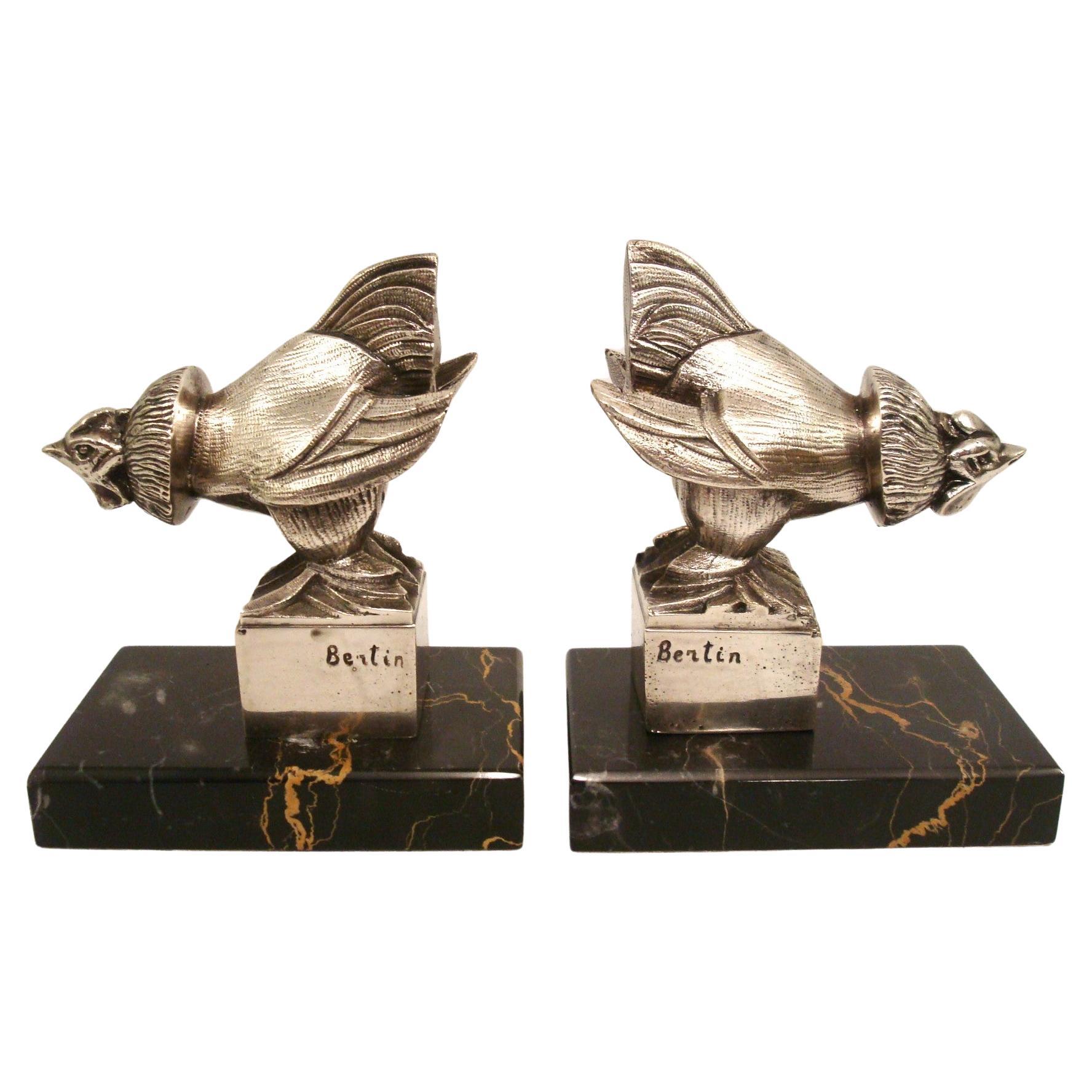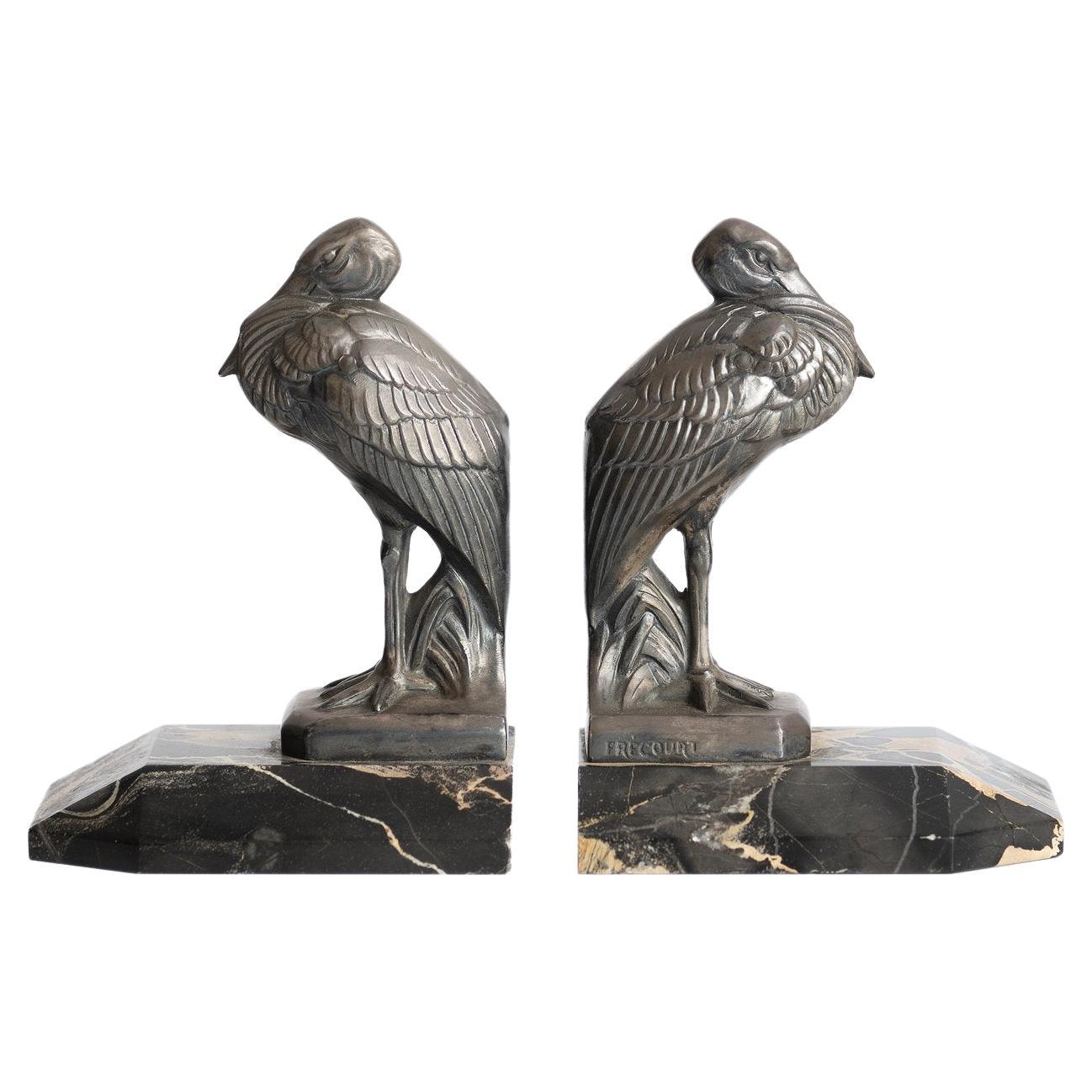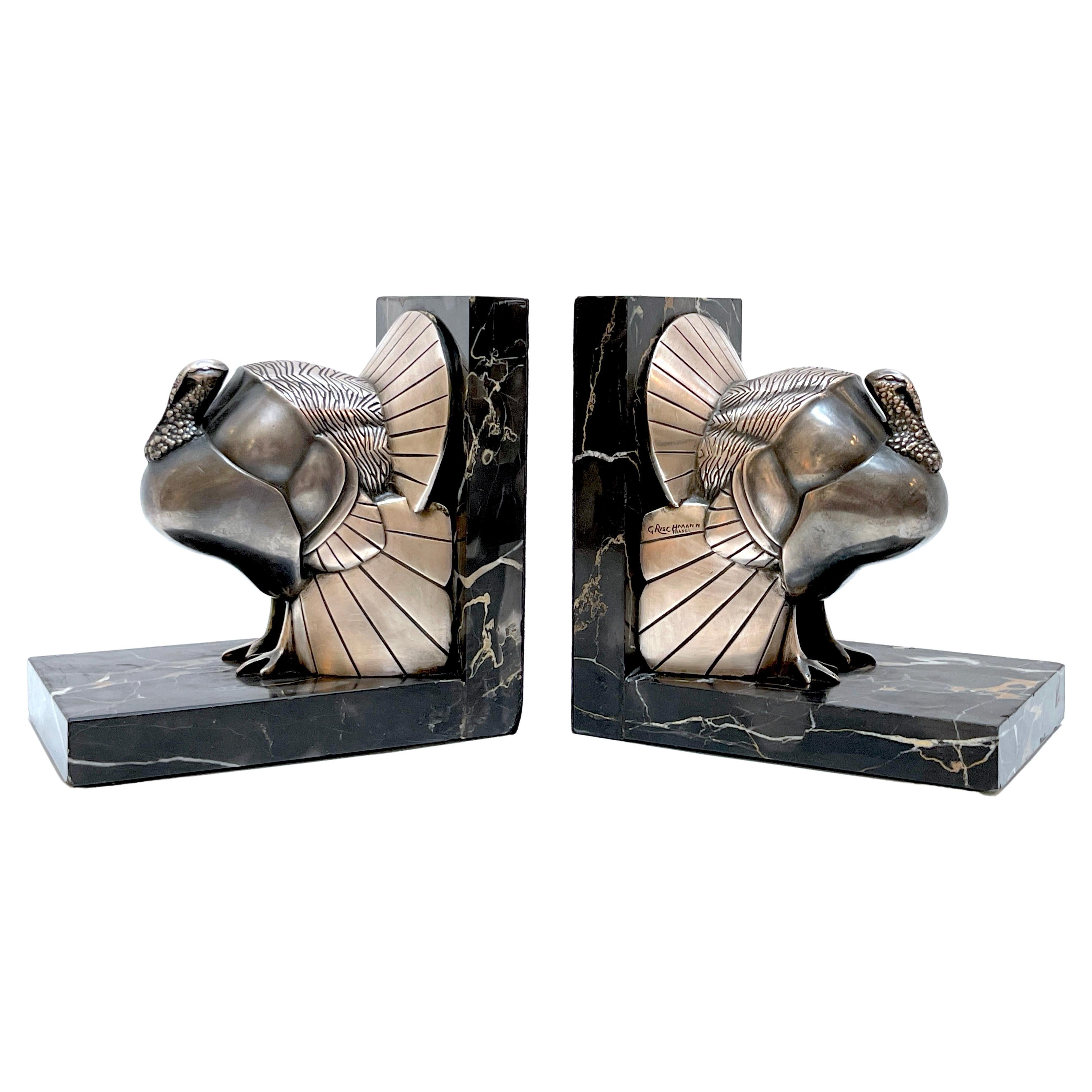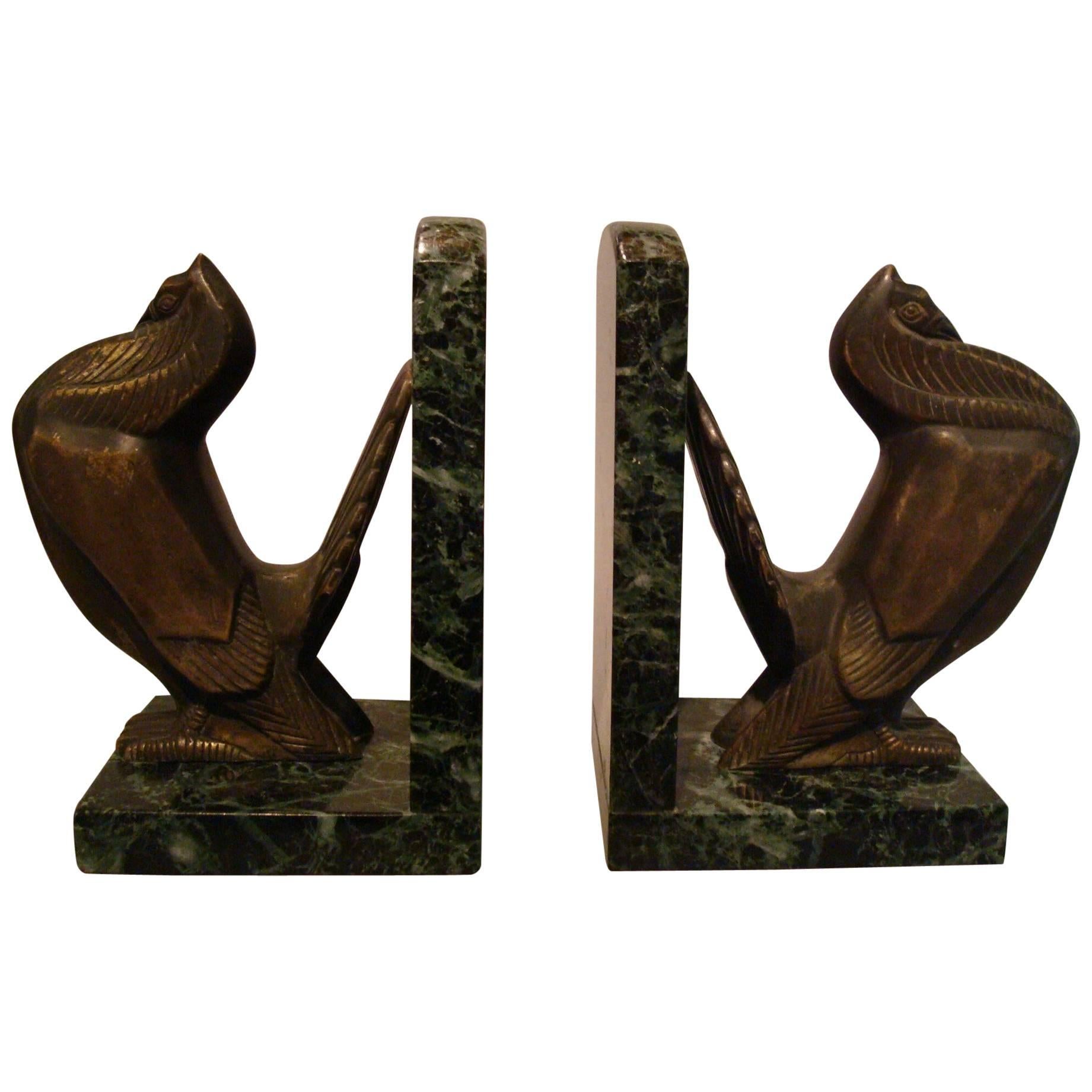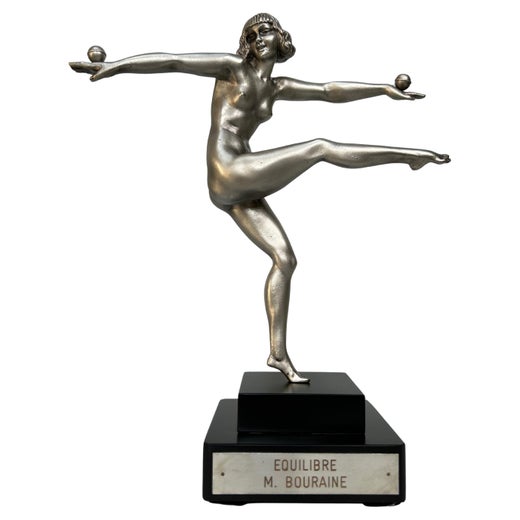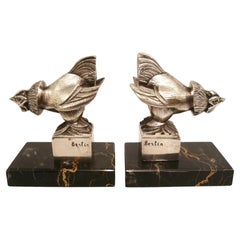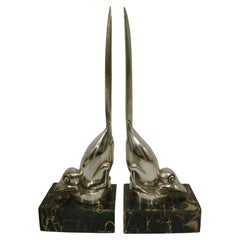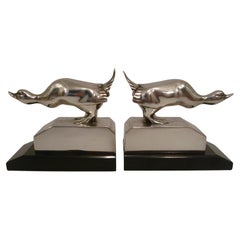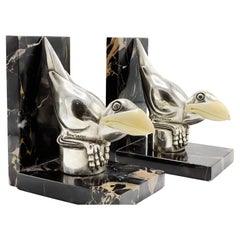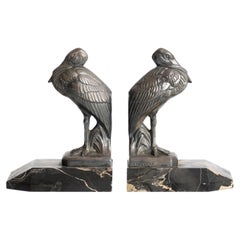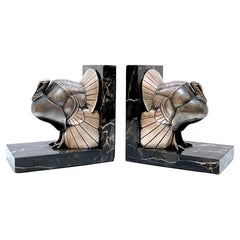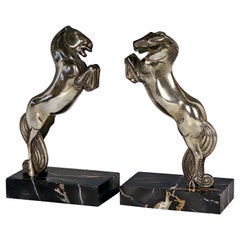Items Similar to Marcel Bouraine Silvered Bronze Pair of Art Deco Roosters Bookends. France 1920s
Want more images or videos?
Request additional images or videos from the seller
1 of 12
Marcel Bouraine Silvered Bronze Pair of Art Deco Roosters Bookends. France 1920s
$2,800
£2,124.58
€2,429.26
CA$3,910.84
A$4,348.32
CHF 2,270.45
MX$52,929.68
NOK 28,970.01
SEK 27,143.51
DKK 18,130.03
Shipping
Retrieving quote...The 1stDibs Promise:
Authenticity Guarantee,
Money-Back Guarantee,
24-Hour Cancellation
About the Item
Marcel Bouraine Silvered Bronze Pair of Art Deco Roosters Bookends. France 1920s.
These same figures where often used as Car Mascots / Hood Ornaments.
Marcel Bouraine (1886–1948) was a French sculptor. He is known for his work in the Art Deco-era, specifically small statuettes, lamps, bookends, and radiator figures.
Marcel Bouraine was born in 1886 in Pontoise, Île-de-France, France. He studied sculpture under the direction of Joseph-Alexandre Falguière. He exhibited at the Salon des Artistes Français, the Salon d'Automne, and the Salon des Tuileries (1922).
During World War I, Bouraine was a prisoner of war and was taken to Switzerland. He later studied at École Supérieure des Beaux-Arts, Genève.
Bouraine's work was part of the sculpture event in the art competition at the 1924 Summer Olympics. In 1928, he designed statuettes in pâte de verre for glass manufacturer Gabriel Argy-Rousseau. He exhibited two large sculptures at the Exposition Internationale des Arts et Techniques dans la Vie Moderne of 1937 in Paris.
Bouraine's work can be found in museum collections, including at the Art Institute of Chicago, and the Norwich Castle Museum and Art Gallery.
We have specialized in the sale of Art Deco and Art Nouveau and Vintage styles since 1995. If you have any questions we are at your disposal. Pushing the button that reads 'View All From Seller'. And you can see more objects to the style for sale. Why are there so many antiques in Argentina?
In the 1880 – 1940 there was a grate wave of immigration encouraged by the periods of war that were taking place. 1st World War took place between 1914 and 1918 2nd World War took place between 1939 and 1945 The immigrants options were New York or Buenos Aires. Tickets were cheap and in Buenos Aires they were welcomed with open arms, as it was a country where everything was still to be done. Argentina was the country of new opportunities, labour was needed and religious freedom was assured, in many cases the of the family travel first until they were settled and then the rest of the family members join them. In the immigrant museum “Ellis Island Immigrant Building” in New York you can se the promotional posters of the boats that would take them to a new life. Between the years 1895 and 1896, Argentina had the highest DGP (gross domestic product) per capita in the world according to the Maddison Historical Statistics index, this situation arose due to the large amount of food being exported to European countries, which were at war. The Argentinean ships left the port of Buenos Aires with food, but they returned with furniture, clothes and construction elements, (it´s common to see this the old buildings of the historic neighbourhood of San Telmo, the beams with the inscription “Made in England)”, as well as many markets that were built in Buenos Aires, such us the San Telmo Market, whose structure was brought by ship and afterwards assembled in 900 Defensa Street. With the great influence of European immigrants living in the country, the children of the upper classes travelled to study in France, resulting in the inauguration of “La Maison Argentinienne”, on 27th of June 1928, in the international city of Paris, which hosted many Argentinians that were studying in Frace. It´s the fourth house to be built after France, Canada and Belgium, being the first Spanish-speaking one. Still in place today (17 Bd Jourdan, 75014, Paris, France). Many of the children of these wealthy families who attended international art exhibitions, museums and art courses abroad, took a keen interest in the European style. This is why Buenos Aires was at the time referred as “The Paris of South America”. Between the years 1890 and 1920 more than a hundred Palaces were built on Alvear Avenue the most exclusive avenue in Buenos Aires. Today some of these palaces have been transformed into museums, hotels and embassies. In the year 1936, the Kavanagh building was inaugurated, it was the tallest reinforced concrete building in South America. During 1994 the American Society of Civil Engineers distinguished it as an “international engineering milestone”, and it´s now considered a World Heritage of Modern Architecture. At the time was common to hire foreign architects such as Le Corbusier, who visited Buenos Aires/Argentina in 1929 and in 1948 he drew up the blueprints for a house built in La Plata City (which was declared a World Heritage Site). In 1947, the Hungarian architect Marcelo Breuer designed “Parador Ariston” in the seaside city of Mar del Plata. After an Argentinean student at Harvard University convinced him to come to Argentina. He worked on an urban development project in the Casa Amarilla, area of La Boca. The Ukrainian architect, Vladimiro Acosta, arrives in Argentina in 1928 and worked as an architect until que moved to Brazil. Antonio Bonet, a Spanish architect who worked with Le Corbusier in Paris, arrives in Argentina in 1937, where he carried out several architectural works and in 1938 designs the well-known BFK chair. Andres Kálnay, of Hungarian origin, made around 120 architectural masterpieces, among which the former Munich brewery stands out, he even made the furniture’s design. The German architect, Walter Gropius, director of the Bauhaus, lived in Argentina, where he wrote articles for “Sur” magazine and founded in Buenos Aires, an architectural firm with Franz Möller, who was also an architect, where he built two houses. At the same time several famous designers decided to immigrate to Argentina, among them we can find the well-known French designer, Jean-Michel Frank, who arrived in the country in 1940 and also worked for the Rockefeller family. Special pieces were made, which were sold exclusively in the country, such as the well-known German company “WMF”, who sold their products by catalogue, which were chosen by the ladies of high society in the list of wedding gifts, as well as the pieces designed by Christofle. The Swiss sculptor Alberto Giacometti, made special pieces for Argentinean mansions. In 1904 the first Jansen branch outside Paris was established in Buenos Aires, as the Argentinean clientele demanded a large amount of furniture, from the end of the 19th century to the mid-20th century. In 1970, the brand Rigolleau Argentina made pieces authorised by Lalique. The brands Maple and Thompson also set up shop in the country. The French plastic artist, Marcel Duchamp moved to Argentina in 1918-1919. Glass signed Gallé, Charder, Leverre, Schneider, Muller and other French firms. They were bought in flower shops and were given to ladies with beautiful floral arrangements. Some furniture manufacturers travelled to international fairs and bough the patterns to produce the furniture in Argentina, such as the furniture firm Englander and Bonta, who bought the patterns in Italy. It is worth mentioning that in Argentina we have the largest community of Italians outside of Italy, as it is estimated that 70 percent of the inhabitants have at least one Italian descendant, followed by Spanish immigrants. The most Important furniture stores in Argentina: Comte is founded in 1934 (under the direct management of Jean Michel Frank in 1940). Nordiska (Swedish company established in 1934). Churba in 1960, a company that brought foreign designers to present their furniture in the country: Denmark: (Arne Jacobsen, Finn Juhl, Bender Madsen, Ejner Larsen, Poul Kjaerholm, Hans Wegner) Sweden: (Hans Agne Jakobsson, Gustavsberg) United States: (Herman Miller) Finland: (Lisa Johansson, Folke Arstrom, Tapio Wirkkala, Alvar Aalto, Timo Sarpaneva) Swedish Factory: (Orrefors) Italy: (Littala, Vico Magistretti, Emma Gismondi, Gae Aulenti, Angelo Mangiarotti, Elio Martinelli, Gianna Celada, Angelo Mangiarotti, Mario Bellini, Carlo Scarpa) Finland: (Olivia Toikka) Plata Lappas (Lappas Silver): a goldsmith shop founded in 1887 in Argentina by Alcibiades Lappas of Greek origin. In 2019, in Argentina took place “the Art Deco world congress” . Argentina currently has more than 100 Art Deco buildings and another 90 Art Nouveau buildings throughout the city of Buenos Aires. Argentina is a country that has not been involved in many wars, which is why it has been a refuge for works of art and antiques from different periods of time, unlike European countries. That is way many collectors, museums and antique dealers from all over the world visit it, you should not miss the opportunity to visit this great country.
- Creator:Marcel-André Bouraine (Artist)
- Dimensions:Height: 6.3 in (16 cm)Width: 3.94 in (10 cm)Depth: 3.15 in (8 cm)
- Style:Art Deco (In the Style Of)
- Materials and Techniques:
- Place of Origin:
- Period:
- Date of Manufacture:1920´s
- Condition:Wear consistent with age and use.
- Seller Location:Buenos Aires, AR
- Reference Number:1stDibs: LU2027343242732
Marcel-André Bouraine
Studied under Joseph Falguiere in France. .He is highly regarded by Art Deco collectors and his works are usually in bronze or bronze and ivory or marble. He also worked with Argy Rouseau and created pate de verre lamps and sculptures. Bouraine was also a member of the Evolution Group. There is considerable information on his work online.
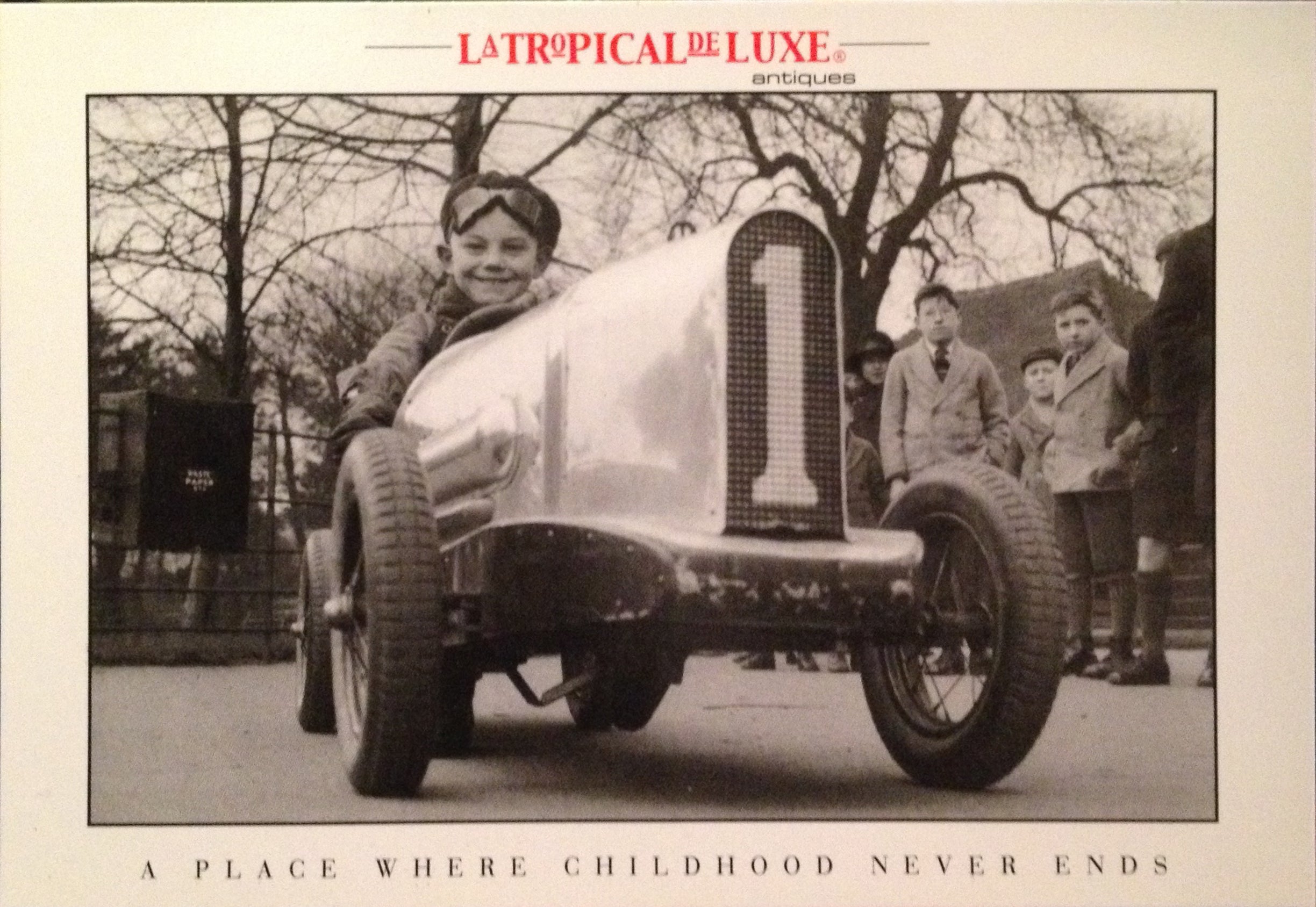
About the Seller
4.9
Vetted Professional Seller
Every seller passes strict standards for authenticity and reliability
Established in 2002
1stDibs seller since 2016
320 sales on 1stDibs
Typical response time: 1 hour
- ShippingRetrieving quote...Shipping from: Buenos Aires, Argentina
- Return Policy
Authenticity Guarantee
In the unlikely event there’s an issue with an item’s authenticity, contact us within 1 year for a full refund. DetailsMoney-Back Guarantee
If your item is not as described, is damaged in transit, or does not arrive, contact us within 7 days for a full refund. Details24-Hour Cancellation
You have a 24-hour grace period in which to reconsider your purchase, with no questions asked.Vetted Professional Sellers
Our world-class sellers must adhere to strict standards for service and quality, maintaining the integrity of our listings.Price-Match Guarantee
If you find that a seller listed the same item for a lower price elsewhere, we’ll match it.Trusted Global Delivery
Our best-in-class carrier network provides specialized shipping options worldwide, including custom delivery.More From This Seller
View AllArt Deco Silvered Bronze Rooster Bookends. France 1920´s.
Located in Buenos Aires, Olivos
Art Deco Silvered Bronze Rooster Bookends. France 1920´s.
Signed by french artist Bertin.
Silvered Bronze sculptures mounted over black and golden marble bases.
Excellent conditions...
Category
Early 20th Century French Art Deco Bookends
Materials
Marble, Bronze
$1,120 Sale Price
20% Off
Art Deco Silver Plated Bronze Birds Bookends, M. Bouraine, France, 1925
By Marcel-André Bouraine
Located in Buenos Aires, Olivos
Pair of Art Deco silvered bronze bird bookends. Silver plated bronze figures mounted over black and gold italian marble bases.
Both signed M. Bouraine and marked france.
Very clean l...
Category
Vintage 1920s French Art Deco Bookends
Materials
Marble, Bronze
Art Deco Turkey Bronze Bookends Signed Irenee Rochard
By Irénée Rochard
Located in Buenos Aires, Olivos
Art Deco Turkey bronze bookends signed Irenee Rochard. Very nice with original patina, mounted over marble bases.
Irénée René Rochard (French, 1906 ~ 19...
Category
Vintage 1920s French Art Deco Animal Sculptures
Materials
Bronze
Art Deco Silvered Bronze Duck Bookends G.H. Laurent France 1925
By Georges H. Laurent
Located in Buenos Aires, Olivos
Art Deco silvered bronze duck bookends G.H. Laurent France 1925.
Pair of Art Deco silvered bronze bookends by the famous French artist G.H. Laurent. Signed and numbered, circa 1925. ...
Category
Vintage 1920s French Art Deco Animal Sculptures
Materials
Marble, Bronze
Art Deco Jacques Cartier Horse Bookends Bronze Sculpture, c 1930, France
By Jacques Cartier
Located in Buenos Aires, Olivos
Art Deco Jacques Cartier horse bookends bronze sculpture. c 1925 France. A stunning pair of art deco stylized bookends. Silvered plated bronze Art Deco h...
Category
Mid-20th Century French Art Deco Animal Sculptures
Materials
Marble, Bronze
Pair of Antique Solid Silver Cockerels or Roosters in an Attitude of Fighting
Located in Buenos Aires, Olivos
Pair of antique solid silver cockerels or roosters in an attitude of fighting. These fighting cockerels are created with a wonderful attention to detai...
Category
20th Century Unknown American Colonial Animal Sculptures
Materials
Sterling Silver
$1,999 / set
Free Shipping
You May Also Like
Marcel Bouraine Art Deco Bronze Bird Bookends 1930s
By Marcel-André Bouraine
Located in Autonomous City Buenos Aires, CABA
Marcel Bouraine Art Deco Bronze Bird Bookends 1930s
These Art Deco bookends by Marcel Bouraine are playful pieces made of silvered bronze and moun...
Category
Vintage 1930s French Art Deco Animal Sculptures
Materials
Marble, Bronze
Antique Art Deco ''Heron'' Bookends by Maurice Frecourt 1930 France Art Nouveau
By Maurice Frecourt, Maurice Frecourt
Located in Ijzendijke, NL
Very beautiful and rare pair of spelter bookends featuring herons made by the artist Maurice Frécourt (1890-1961). Executed in the middle of the art deco period around 1930. These tw...
Category
Vintage 1930s French Art Deco Bookends
Materials
Marble, Spelter
$2,032 / set
Free Shipping
Pair Art Deco Silvered-Bronze 'Turkey' Bookends by G. Rischmann France, 1930s
Located in West Palm Beach, FL
Pair Art Deco Silvered-Bronze 'Turkey' Bookends by G. Rischmann France, 1930s
Each one signed in script 'G. Rischmann France'
By Gaston Rischmann (1907-1979)
A unique pair of Art De...
Category
20th Century French Art Deco Bookends
Materials
Marble, Bronze
$1,996 Sale Price / set
20% Off
Art Deco Pair of Bookends by André Vincent Becquerel
By André Vincent Becquerel
Located in Miami, FL
Pair of silver plated bronze bookends depicting two horses seating on a marble by André Vincent Becquerel
Made in France
Circa:1930
Signatur...
Category
Early 20th Century French Art Deco Bookends
Materials
Belgian Black Marble, Bronze
$3,375 Sale Price / set
25% Off
Art Deco Silver Metal Bookends with Malabu by Marcel-André Bouraine
By Marcel-André Bouraine
Located in Autonomous City Buenos Aires, CABA
Art Deco Silver Metal Bookends with Malabu by Marcel-André Bouraine
These Art Deco bookends by Marcel Bouraine are playful pieces made of silvered bronze and mounted on marble, whic...
Category
20th Century French Art Deco Animal Sculptures
Materials
Bronze
Pair of Bronze Sculptures of Fighting Roosters, Japan, 1950s
Located in Barntrup, DE
Pair of Bronze Sculptures of Fighting Roosters, Japan, circa the 1950s
A pair of beautifully and lifelike sculpted bronze roosters with red-painted rooster combs and wattles. These i...
Category
Vintage 1950s Japanese Art Deco Animal Sculptures
Materials
Bronze
More Ways To Browse
Art Nouveau Homes
Canada Antiques
Finnish Antiques
South Street Antiques
Marcel Antique Chairs
Antique Poster Food
Antique Childrens High Chair
Antique Chairs Canada
Art Deco Accent Chairs
Chicago Silver Company
Marble Chair Company
Danish Accent Chairs
I Beam Used
Antique Glass Rooster
Chicago Chair Company
I Beam Sculpture
Art Glass Rooster
Spanish Accent Chair
